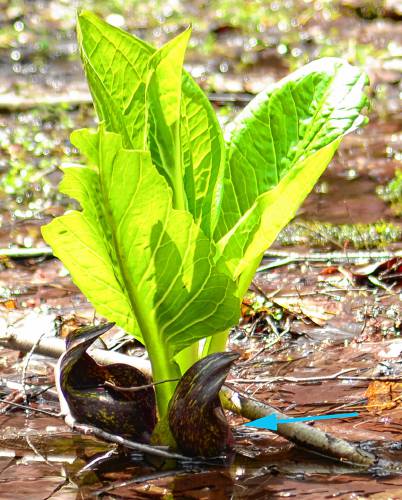Speaking of Nature: Stinky signs of spring: Skunk cabbage is eye candy after months of winter landscape

The gorgeous yellow-green leaves of the skunk cabbage are much easier to notice than the dark red flowers, which I have indicated with the blue arrow. PHOTO BY BILL DANIELSON
| Published: 04-01-2025 12:32 PM |
March Madness is a term that has been assigned to the sport of college basketball. The idea is that a huge tournament creates a frenzied “madness” of athletic exuberance as different teams from across the country compete in a clash of collegiate contenders to see who will be crowned as champion. There are brackets, debates and wagers involved and everyone seems to have a good time.
From the naturalist’s point of view, the term March Madness has a much different meaning. It is a term that describes the monotony of the monochrome landscape of winter. There are no brackets, or debates (though sometimes there are wagers), but the frenzied and chaotic temperament can be very similar to those consumed by the athletic contests. Naturalists afflicted with March Madness are desperately searching for any sign of green; anything to soothe the frazzled nerves of a person cooped up for too long and aching for just a hint of relief from the frosty grip of winter.
And so, inevitably, a search will be conducted. For those of us who must endure a long commute to work the search will be conducted behind the wheel of an automobile. Time and experience will have created an inventory of likely places that will be scrutinized on a daily basis. These places are soggy spots along the sides of certain roads where water might not pool, but it will definitely collect. As the snow melts and the ground thaws, these spots are the places where the first signs of new life can be seen and on that special day when the first hints of fresh chlorophyll are detected, ecstasy floods the soul. I’ll match that against basketball any day.
So what is the source of this miraculous return of life? The answer, dear reader, is the humble skunk cabbage (Symplocarpus foetidus). Named for its distinctive scent, the famous Swedish biologist, Carl Linnaeus (the Father of Modern Taxonomy) chose the species name “foetidus,” which means “bad odor.” Chemicals in the plant’s tissues do give it a smell reminiscent of a skunk, which explains the common name “skunk” cabbage. I happen to adore the less-well known name, “polecat weed.”
The fresh leaves of this plant, emerging from the soggy ground in which it lives, is pure candy to the eyes starved by the dormant winter landscape. A gorgeous yellow-green, these leaves convey an unambiguous message that the end is near. But even before the green leaves appear, the odd flowers of the skunk cabbage emerge. Roughly the same size and color as a red delicious apple, the flowers grow so quickly that the cellular activity can generate enough heat to melt snow. The fetid odor of the flowers attracts carrion flies and, in an interesting extension of last week’s column, black bears.
To survive the northern winter, black bears are forced to go into a deep sleep for the winter months. Also known as a “torpor,” this is not true hibernation because their body temperatures do not fall as low as animals like chipmunks and woodchucks. Instead, the bears sleep deeply and rarely rouse themselves. You have no idea how desperately envious I am of a bear’s ability to sleep.
Anyway, during this long period of inactivity, bears do not eat or drink. When they finally do start to wake up they will be ravenous and, if we ignore human garbage cans, there is little that is edible to be found in the early spring landscape. The big exception is skunk cabbage and bears will eat this toxic plant whenever they find it.
Humans are warned to avoid eating this plant because it has emetic properties and is slightly narcotic. Bears, on the other hand use this toxicity to their advantage because it has the effect of a natural laxative. After months of inactivity, the digestive system of a black bear needs a good flushing and skunk cabbage does the trick. However, the naturalist shudders at the thought. Can you imagine the morning breath of a black bear after sleeping all winter? Now add a fresh meal of skunk cabbage into the mix. Sweet mother of Darwin.
Article continues after...
Yesterday's Most Read Articles
 Long-vacant former Faces spot in Northampton gets new tenant
Long-vacant former Faces spot in Northampton gets new tenant
 Here come the sweetness: Four new businesses prepping to open in downtown Northampton
Here come the sweetness: Four new businesses prepping to open in downtown Northampton
 Local ‘Hands Off!’ standouts planned as part of national effort
Local ‘Hands Off!’ standouts planned as part of national effort
 Northampton schools probe staff response to student’s unfulfilled IEP
Northampton schools probe staff response to student’s unfulfilled IEP
 Area property deed transfers, April 4
Area property deed transfers, April 4
 Sabadosa, Velis push for state endometriosis task force to raise awareness about little-known illness
Sabadosa, Velis push for state endometriosis task force to raise awareness about little-known illness
As I sit and compose this column I can report that one of my skunk cabbage patches is full of life. I wasn’t able to pick up on the presence of the dark-colored flowers as I drove by, but the green leaves are up and approaching a full foot in length. Soon the leaves will spread out and cover the forest floor like lily pads on land and their greenery will nourish the imagination long before the trees show any signs of life. Look for these wonderful plants as you drive around, or better yet take a stroll through a natural area and search for the plants where you can take the time to truly enjoy them and wash the madness from your mind.
Bill Danielson has been a professional writer and nature photographer for 27 years. He has worked for the National Park Service, the US Forest Service, the Nature Conservancy and the Massachusetts State Parks and he currently teaches high school biology and physics. For more in formation visit his website at www.speakingofnature.com, or go to Speaking of Nature on Facebook.






 Arts Briefs: Power of Truths Fest in Florence, dance at Smith, jazz at UMass, and more
Arts Briefs: Power of Truths Fest in Florence, dance at Smith, jazz at UMass, and more ‘Art in the Age of Human Impact’: New exhibition at UMass explores complex relationship between humans and nature
‘Art in the Age of Human Impact’: New exhibition at UMass explores complex relationship between humans and nature Historic speech echoes two centuries later: ‘A Light Under the Dome’ recalls the first American woman to speak to a legislative body
Historic speech echoes two centuries later: ‘A Light Under the Dome’ recalls the first American woman to speak to a legislative body ‘His notes will linger forever’: Remembering Young@Heart accordionist and Springfield College professor Chris Haynes
‘His notes will linger forever’: Remembering Young@Heart accordionist and Springfield College professor Chris Haynes
